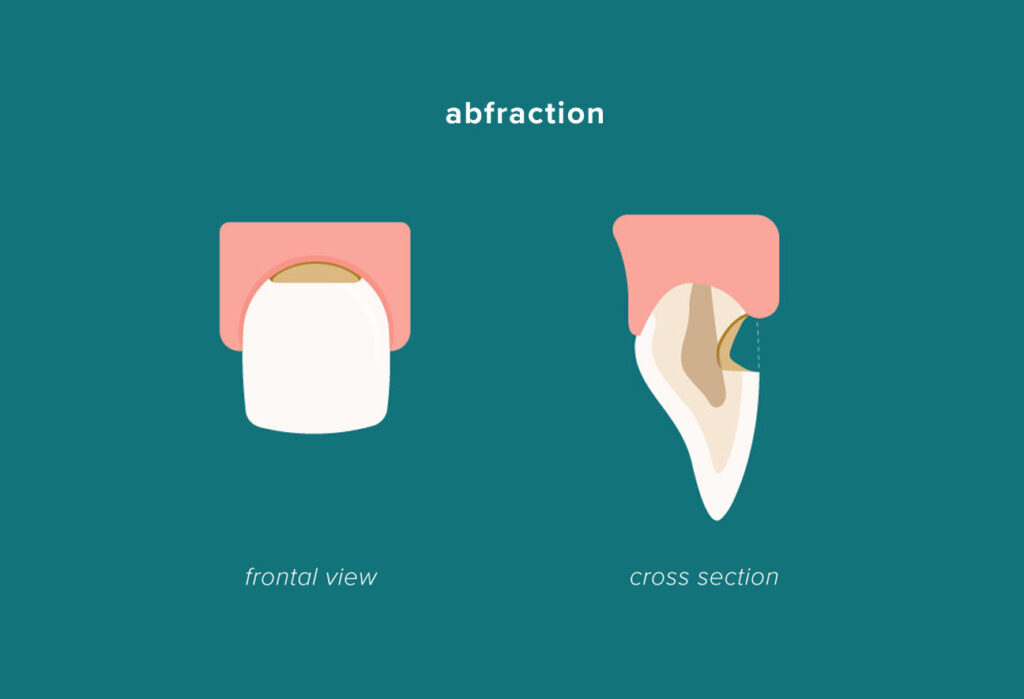Abfraction – A new term for an “old” problem
You probably have not heard this dental term before because it is relatively new to dentistry. It describes a newly recognized problem that has been commonly mistaken for abrasion in the past. Until recently, abfraction was thought to be caused by improper toothbrushing techniques.
An abfraction lesion is now known to be the loss of tooth structure seen clinically on the cheek side of a tooth near and often under the gumline. It is identified by its sharply demarcated horizontal notch-like appearance. While a cavity may develop in the area due to the exposed dentin, the decay process is not responsible for the abfraction.
The Cause
Abfraction is caused when two opposing teeth¾one top and one bottom tooth¾meet improperly during chewing and nonfunctional clenching or tooth grinding habits. At that point of stress, the tooth will “flex” very slightly. When a bite relationship is not correct, teeth undergo forces of compression and tension from the opposing teeth. In this way, the tooth is flexed slightly every time the teeth fully close.
This chronic flexing of the tooth causes a loss of tooth substance (enamel and dentin) at the gumline where the enamel is the thinnest. Enamel is brittle and cannot easily bend. As the tooth is moved back and forth (because the bite is off or because you grind your teeth), pieces of enamel fracture. The dentin, or underlying tooth structure, is more elastic and can bend slightly. The bending of the tooth will slowly damage the tooth, and a notch will eventually become visible.
One characteristic of abfraction that can make diagnosis difficult is that it may be partially or entirely under the gum tissue. At one time, it was thought that this type of tooth notching was caused by improper brushing habits, such as forcefully scrubbing back and forth against the neck of the tooth. While it is true that you can actually wear a notch in the tooth by brushing too hard in a see-saw fashion, the first tissue to wear away under those conditions is the gum tissue. Unlike abfraction, abrasion occurs above the gumline. In contrast, an abfraction occurs many times under the gum, or is partially covered by gum tissue.
Treatment Options
Your occlusion (bite) must be checked and adjusted so that your teeth meet properly in all jaw movements. This bite adjustment may require more than one appointment to successfully complete, depending on the specific nature of the occlusal problem.

Second, the notch in the tooth must be treated. The missing enamel and underlying exposed dentin need to be replaced and covered. Dentin is not designed to be exposed to the oral environment; that’s why it is naturally covered with enamel. Even when the factors that initially caused the notch have been eliminated, the exposed dentin may continue to abrade because dentin is soft. This exposed dentin may decay. The tooth may also become sensitive to temperature changes. It can become weaker.
A tooth-colored, bonded resin material is often placed to restore the notched tooth, and is a relatively easily restoration to accomplish. If the notch extends deep under the gumline, the tissue may have to be removed to expose the extent of the notched area in order to restore it.
If all procedures are successful, the abfraction notch will be restored to exactly match the natural tooth structure and the bite will be adjusted so that the teeth meet properly. Please be aware that if the teeth shift slightly, or if you continue to grind your teeth, the restored tooth may begin to flex again and the restoration could be forced out. Or, other teeth may begin to exhibit the same type of enamel loss. If this occurs, the bite can again be adjusted and a new restoration can be placed.
If you have any questions about abfraction, please feel free to ask us.
